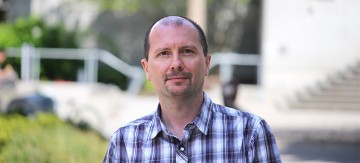In his quest to figure out cancer, health geographer Trevor Dummer helped assemble the world’s largest collection of toenail clippings
Health geographer Trevor Dummer, recently recruited as an associate professor in the Cancer Prevention Centre of UBC Faculty of Medicine’s School of Population and Public Health, uses mapping and other geographic tools to understand the relationship between the environment and health, particularly related to cancer risk. Dummer talks about how our surroundings impact our health from head to toe.

Health geographer Trevor Dummer studies how our surroundings impact our health. Photo: Cancer Prevention Centre.
What is health geography?
We know that geography—where we were born, live, work, or study—affects our health in many ways. Geography affects our lifestyle, the food we eat, the air we breathe and the water we drink. Health geographers try to untangle some of the complex factors in the built and natural environment that have impacts on human health. We do that by mapping people and disease risk factors, because by understanding spatial patterns in disease, we begin to understand risk factors that can be targeted for prevention. Geographers work to understand communities and neighbourhoods; as a health geographer I focus on disease prevention for communities and populations at risk.
How did you end up with the world’s largest toenail collection?
I spent the past seven years helping to establish the Atlantic Partnership for Tomorrow’s Health (PATH) Project. We successfully recruited 35,000 Atlantic Canadians whose health will be tracked over the next 25 years, and the project will be a major resource for cancer prevention research. More than 22,000 participants provided blood and toenail clippings, which ended up being an official Guinness World Record.
We assessed levels of heavy metal contaminants, including arsenic, in toenails. By examining this toenail collection, we found that arsenic bioaccumulation is closely linked to arsenic occurrence in well-water, but people with more body fat had significantly lower levels of arsenic in their toenails. For some reason, obesity seems to be protective against arsenic accumulation, but excess weight is linked to increased risk for several types of cancers and chronic health conditions. We haven’t yet figured out why excess body fat reduces arsenic bioaccumulation, but we think we’re getting closer to understanding the biological processes at work. Since consuming arsenic is linked to cancer, we are also trying to find ways to reduce arsenic exposure.
What are you doing to study the differences between cancer rates across Canada?
It is well established that cancer rates decrease as we move from east to west across Canada. We don’t yet know why this is the case. By building on my experiences with the Atlantic PATH project and forging new partnerships with the many world-class researchers at UBC, I hope to develop novel and interesting prevention approaches in response to the cancer gradient problem.
The Cancer Prevention Centre is a partnership between the Canadian Cancer Society and the University of British Columbia.